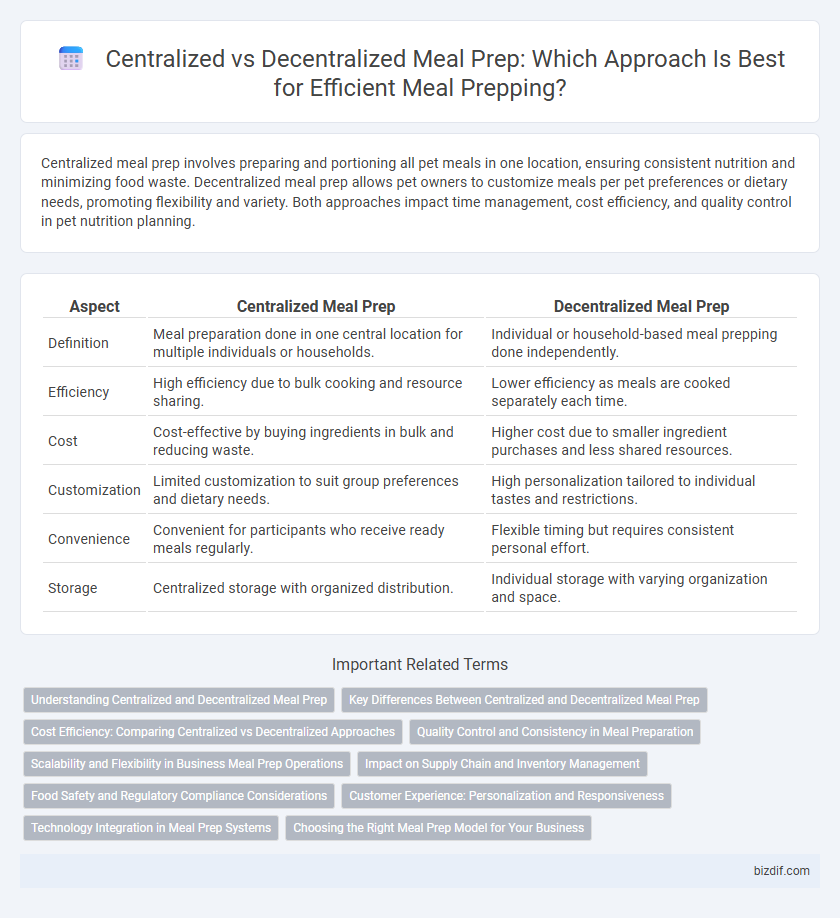Centralized meal prep involves preparing and portioning all pet meals in one location, ensuring consistent nutrition and minimizing food waste. Decentralized meal prep allows pet owners to customize meals per pet preferences or dietary needs, promoting flexibility and variety. Both approaches impact time management, cost efficiency, and quality control in pet nutrition planning.
Table of Comparison
| Aspect | Centralized Meal Prep | Decentralized Meal Prep |
|---|---|---|
| Definition | Meal preparation done in one central location for multiple individuals or households. | Individual or household-based meal prepping done independently. |
| Efficiency | High efficiency due to bulk cooking and resource sharing. | Lower efficiency as meals are cooked separately each time. |
| Cost | Cost-effective by buying ingredients in bulk and reducing waste. | Higher cost due to smaller ingredient purchases and less shared resources. |
| Customization | Limited customization to suit group preferences and dietary needs. | High personalization tailored to individual tastes and restrictions. |
| Convenience | Convenient for participants who receive ready meals regularly. | Flexible timing but requires consistent personal effort. |
| Storage | Centralized storage with organized distribution. | Individual storage with varying organization and space. |
Understanding Centralized and Decentralized Meal Prep
Centralized meal prep involves preparing all meals in one location, maximizing efficiency and consistency in portion control and ingredient usage. Decentralized meal prep allows individuals to prepare meals independently, offering flexibility and customization based on personal dietary preferences. Understanding these methods helps optimize time management and nutritional goals in meal planning strategies.
Key Differences Between Centralized and Decentralized Meal Prep
Centralized meal prep involves preparing all meals in one location, ensuring consistent portion sizes and streamlined ingredient management, which reduces food waste and saves time. Decentralized meal prep distributes cooking tasks among multiple individuals or locations, offering greater flexibility and customization but requiring more coordination and potentially higher costs. Key differences include the scale of operation, control over recipe consistency, and efficiency in ingredient usage.
Cost Efficiency: Comparing Centralized vs Decentralized Approaches
Centralized meal prepping significantly reduces costs by bulk purchasing ingredients and utilizing shared kitchen resources, leading to economies of scale. Decentralized meal prepping often incurs higher expenses due to individual ingredient purchases and duplicated equipment use across multiple locations. Evaluating cost efficiency reveals centralized models generally offer more savings, especially for large-scale meal production.
Quality Control and Consistency in Meal Preparation
Centralized meal prep ensures superior quality control by consolidating cooking processes in a single location, allowing chefs to maintain strict standards and consistent flavor profiles across all meals. Decentralized meal prep, while providing flexibility and customization, faces challenges in standardizing portion sizes, seasoning, and cooking techniques, potentially leading to variability in meal quality. Implementing rigorous training and standardized recipes is crucial for decentralized systems to achieve consistency comparable to centralized operations.
Scalability and Flexibility in Business Meal Prep Operations
Centralized meal prep enables higher scalability by consolidating resources and production in a single facility, reducing overhead and streamlining quality control for business meal prep operations. Decentralized meal prep offers greater flexibility by allowing multiple smaller kitchens to customize menus and adjust quickly to local demand variations, enhancing responsiveness and customer satisfaction. Balancing scalability and flexibility is crucial for optimizing operational efficiency and meeting diverse client needs in business meal prep services.
Impact on Supply Chain and Inventory Management
Centralized meal prep streamlines supply chain operations by consolidating ingredient purchasing, reducing redundancy, and improving inventory turnover through bulk ordering. Decentralized meal prep, while offering flexibility and customization at individual locations, often leads to fragmented inventory systems, increased stock discrepancies, and higher procurement costs due to smaller, varied orders. Efficient supply chain and inventory management favor centralized models for scalability and cost control, whereas decentralized approaches require advanced tracking technologies to mitigate inefficiencies.
Food Safety and Regulatory Compliance Considerations
Centralized meal prep facilities streamline food safety protocols by implementing standardized procedures and rigorous quality controls, reducing contamination risks and ensuring compliance with health regulations. Decentralized meal prep, while offering flexibility, faces challenges in maintaining consistent sanitation standards and regulatory adherence across multiple locations. Effective training and monitoring are crucial to uphold food safety and meet regulatory requirements in both centralized and decentralized meal preparation systems.
Customer Experience: Personalization and Responsiveness
Centralized meal prep offers consistent quality and streamlined delivery, ensuring a reliable customer experience with standardized menu options. Decentralized meal prep enhances personalization by allowing customization based on local preferences and immediate responsiveness to individual dietary needs. Customers seeking tailored meals often favor decentralized models for their flexibility and direct engagement with meal providers.
Technology Integration in Meal Prep Systems
Centralized meal prep systems leverage advanced kitchen automation and inventory management software to streamline workflow and reduce food waste, enhancing efficiency on a large scale. Decentralized meal prep incorporates user-friendly mobile apps and real-time data syncing, enabling personalized meal customization and flexible scheduling across multiple locations. Integration of IoT devices in both models allows precise monitoring of cooking times and temperatures, ensuring consistent quality and safety standards.
Choosing the Right Meal Prep Model for Your Business
Choosing between centralized and decentralized meal prep models depends on your business scale, target market, and operational capacity. Centralized meal prep offers cost efficiency and consistent quality by preparing meals in a single location, ideal for scaling and maintaining strict quality controls. Decentralized meal prep enables faster delivery times and customization by preparing meals closer to customers, suitable for businesses prioritizing local freshness and personalized service.
Centralized meal prep vs decentralized meal prep Infographic

 bizdif.com
bizdif.com